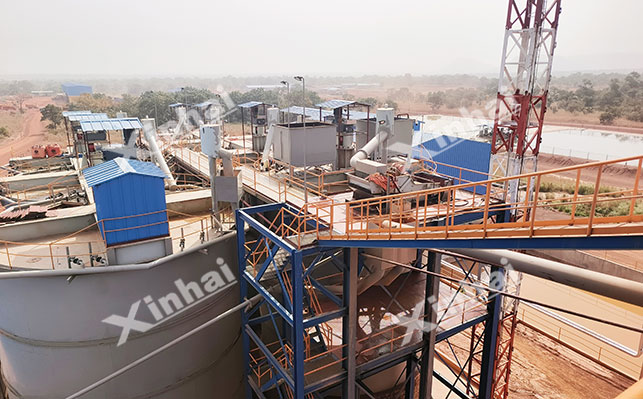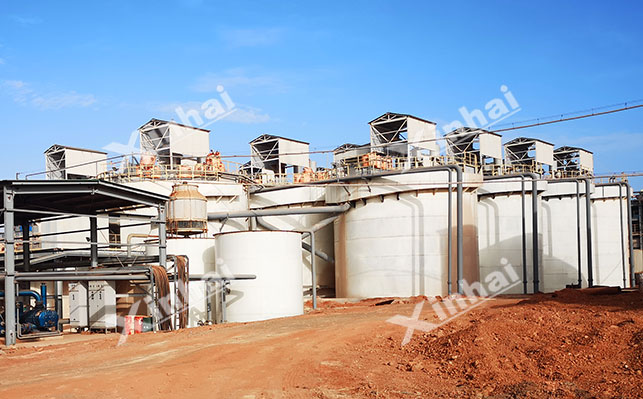
15311826613
Click to add WeChatWith the continuous growth of global demand for gold and the gradual depletion and complexity of gold resources, efficient mineral processing technology has become the focus of the industry. Carbon slurry gold extraction technology is one of the commonly used processes for gold selection. With its own advantages, it has been widely used in gold selection technology. Below we introduce carbon slurry gold extraction technology, including process, flow, applicable conditions and advantages and disadvantages.

Carbon slurry gold extraction, the full name is activated carbon slurry adsorption gold extraction process, is a mineral processing technology that directly extracts gold from cyanide slurry. Its principle is based on the strong adsorption capacity of activated carbon to gold cyanide complex. After the gold ore is specifically treated, the gold exists in the slurry solution in the form of gold-cyanide complex. The activated carbon enriches the gold-cyanide complex on its surface through the dual effects of physical adsorption and chemical adsorption, thereby separating the gold from other impurities in the slurry, and then extracting the gold through a series of subsequent treatments.
In gold ore resources, there are a large number of fine gold particles and gold closely associated with other minerals, which are difficult to be effectively recovered by traditional mineral processing methods. The carbon slurry gold extraction process can effectively recover such gold ores, achieve fine particle separation and enrichment, and simplify the traditional mineral processing process.
Fine particle separation and enrichment: It is to separate and enrich the gold in the gold ore from the complex ore system. The gold is dissolved by cyanide leaching, and then the activated carbon is used for adsorption to enrich the low concentration of gold-cyanide complex on the surface of the activated carbon, so as to achieve effective separation of gold from a large number of gangue minerals and other impurities, laying the foundation for subsequent gold extraction and refining.
Simplified process: Compared with traditional mineral processing technology, carbon slurry gold extraction process reduces multiple intermediate links, such as solid-liquid separation of leaching solution, purification of precious liquid, etc. Direct adsorption operation in the ore pulp greatly simplifies the process flow, reduces equipment investment and operating costs, and also reduces the gold loss that may be caused by complex processes.
The process flow of carbon slurry gold extraction mainly includes ore preparation, cyanide leaching, activated carbon adsorption, desorption electrolysis and smelting.
The ore preparation operation of carbon slurry gold extraction is mainly to crush and grind the large ore blocks after mining, so that the gold particles are fully dissociated from the gangue minerals, creating conditions for subsequent cyanide leaching. This stage process is divided into crushing process and grinding process.

Crushing process: First, crushing equipment is used for coarse and fine crushing operations to reduce the ore particle size to a certain extent. Usually jaw crusher is used for coarse crushing, and the particle size is controlled between 150mm and 300mm; cone crusher is used for medium and fine crushing, and the target particle size is usually around -10mm to -20mm.
Grinding process: After crushing, the mineral has not achieved monomer dissociation state, which needs to be achieved through grinding, usually completed by ball mill or rod mill. According to the ore particle size requirements, two-stage closed-circuit grinding or two-stage open-circuit grinding is designed, and the product particle size reaches -0.074mm, accounting for about 60%-80%. In addition, during the grinding process, appropriate amount of water and grinding aids will be added to improve grinding efficiency and reduce energy consumption.
The cyanide leaching process uses cyanide (such as sodium cyanide, potassium cyanide) to react chemically with gold under alkaline conditions to dissolve gold to form gold-cyanide complex.
Put the ground slurry into the leaching tank, adjust the slurry concentration to 30%-40% (mass fraction), add appropriate amounts of cyanide and lime, and keep the slurry pH between 10-11 to prevent cyanide hydrolysis from producing toxic hydrogen cyanide gas. At the same time, mechanical stirring or aeration stirring is used to make the oxygen content in the slurry sufficient to promote the dissolution reaction of gold. The leaching time is generally 24-48 hours, and the specific time depends on the properties of the ore and the occurrence state of gold.
Activated carbon has a large specific surface area and rich microporous structure. The gold-cyanide complex is adsorbed on the surface of activated carbon through physical adsorption and chemical adsorption. Physical adsorption is based on the van der Waals force between molecules, and chemical adsorption is due to the chemical reaction between certain functional groups on the surface of activated carbon and the gold-cyanide complex. The slurry after cyanide leaching passes through the activated carbon adsorption column in series, and the slurry flows slowly in the column and is in full contact with the activated carbon. Generally, a multi-stage countercurrent adsorption method is adopted, that is, fresh activated carbon is added from the tail adsorption column, and the slurry enters from the initial adsorption column, which can improve the adsorption efficiency of activated carbon and the recovery rate of gold. As the adsorption process proceeds, the amount of gold adsorbed on the activated carbon gradually increases. When it reaches a certain saturation, the activated carbon needs to be replaced.

Desorption electrolysis is to put the activated carbon adsorbed with gold into the desorption column, and by heating the desorption liquid (generally a mixed solution of sodium hydroxide and sodium cyanide), the gold cyanide complex is desorbed from the surface of the activated carbon and enters the desorption liquid. The desorption process is the reverse process of adsorption. By changing the temperature, solution composition and other conditions, the adsorption balance between the gold cyanide complex and the activated carbon is destroyed.
The gold-containing solution after desorption enters the electrolytic cell. Under the action of direct current, the gold cyanide complex undergoes a reduction reaction on the cathode, and the gold ions obtain electrons and deposit on the cathode surface to form gold mud. During the electrolytic process, it is necessary to control parameters such as current density, cell voltage, and solution temperature to improve the electrolytic efficiency and gold mud quality.
The purpose of smelting is to smelt the gold mud obtained by electrolysis, remove impurities in it, and obtain high-purity gold ingots. The main reason is that in addition to gold, the obtained gold mud also contains a small amount of impurities such as silver, copper, and lead, which need to be oxidized or slag-formed by smelting. Generally, smelting equipment such as crucible furnaces and arc furnaces are used to mix the gold mud with an appropriate amount of flux (such as borax, sodium carbonate, etc.) and put it into the furnace. Smelting is carried out at high temperature (generally at 1200-1300℃). The smelted gold liquid is poured into the mold and cooled to obtain gold ingots.
Fine-grained gold ore: When gold particles are dispersed in the ore in fine particles, conventional gravity separation, flotation and other methods are difficult to achieve effective recovery, and the carbon slurry gold extraction process has good advantages. Because it can adsorb fine-grained gold in the slurry state, it is not limited by the particle size of gold particles.

Ores with high mud content: For gold ores with high mud content, other beneficiation methods are easily interfered by mud, resulting in a decrease in beneficiation indicators. In the process of cyanide leaching, the carbon-in-slurry gold extraction process can make the gold-cyanide complex dissolve smoothly and be adsorbed by activated carbon through reasonable slurry concentration control and stirring conditions, reducing the impact of mud on gold recovery.
Ore with high oxidation degree: In oxidized gold ores, the occurrence state of gold is relatively complex, and some gold may exist in the form of oxides or other insoluble forms. The carbon-in-slurry gold extraction process combined with cyanide leaching can convert oxidized gold into soluble gold-cyanide complexes, thereby realizing gold recovery.
Concentrators with limited sites: The carbon-in-slurry gold extraction process is suitable for large-scale gold ore concentrators because its equipment is relatively concentrated and the floor area is relatively small. It can also operate efficiently under limited site conditions. And large-scale production can give full play to the low cost advantage of this process and improve production efficiency.
The overall effect of carbon-in-slurry gold extraction is good, with the advantages of high recovery rate, strong adaptability to ore, and continuous and automated production. For fine-grained gold (or gold in microscopic or submicroscopic state) and gold closely associated with other minerals, the carbon-in-slurry gold extraction process can achieve efficient recovery, and the recovery rate can usually reach more than 90%-95%. This is because the process is adsorbed in the slurry state, is not limited by the particle size and embedding characteristics of gold particles, and can fully capture the gold in the ore.
In addition, the carbon-in-slurry gold extraction process can achieve continuous and automated production, can process a large amount of ore, and the production scale can be adjusted according to actual needs. It can be applied from smaller-scale concentrators to large-scale mining companies. Through reasonable equipment configuration and process flow design, efficient ore processing and gold recovery can be achieved, production efficiency can be improved, and unit production costs can be reduced.
As a highly efficient, economical and adaptable gold ore beneficiation method, the carbon-in-slurry gold extraction process plays an important role in global gold production. Despite the challenges of activated carbon consumption and cyanide toxicity, with the continuous advancement of technology, the birth of new activated carbon and the emergence of cyanide substitutes are a strong guarantee for improving the sustainable development of carbon-in-slurry gold extraction technology.